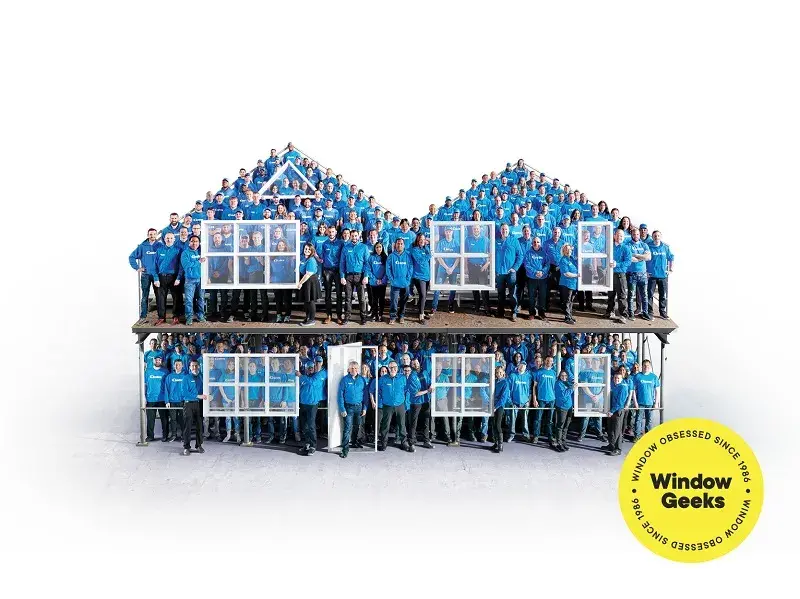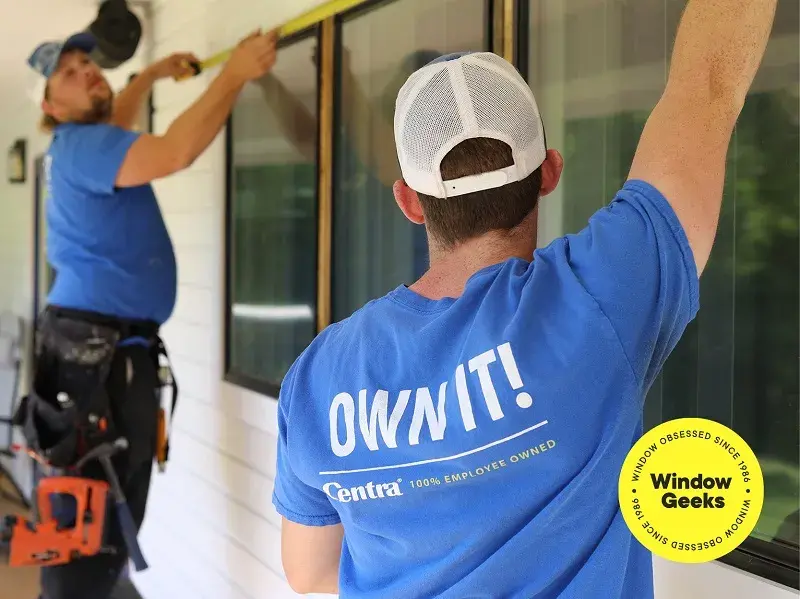Categories
Trending
Comfort
When To Repair New Windows
Energy Savings Rebates
The Benefits of Triple Pane Sliding Windows & Doors
Centra Cares In The News
2024: Another Great Year for Centra Cares
Recommended
Master Class
Air & Water Tightness White PaperMaster Class
Enforcing AirtightnessGuard Loading White Paper
To understand guard loading, we should first understand common glass types available on the market and their configurations.
Glass Types:
- Tempered Glass (stronger glass that breaks into small pieces)
- Laminated Glass (consists of two or more glass layers attached by plastic interlayer(s). Glass remains attached to these interlayers when broken)
- Annealed Glass (“normal” glass)
What glass is required for guards in the BC Building Code?
The BC Building Code requires glass in guards to be one of the below (safety glass):
- Tempered Glass
- Laminated Glass
- Wired Glass (used to prevent spread of smoke in a fire)
It’s worth noting that guard loads are distinct from kick protection.
Durability of Wired Glass Compared to Other Safety Glass
Wired glass has inherent issues and is actually weaker than annealed glass. Despite this article, Wired glass to lose safety designation in Canada, wired glass is still technically a safety glass in the building code. For all purposes other than mitigation in cases of a fire, do not use wired glass. Ironically, despite its safety glass designation, we do not supply wired glass due to safety issues.
Tempered glass has the possibility of spontaneous breakage, sometimes after many years, due to the inclusion of nickel sulphide. Although it is possible to reduce the probability of this occurring using heat-soaking and other techniques, the risk cannot be fully eliminated. However, the likelihood is low enough that it’s generally not a concern. Below is a figure showing recorded breakages for a building with 108 tons of glass with an area of 3500 m^2 (37674 ft^2) (not heat-soaked)[1]. We can see that the chances of a spontaneous breakage first increase, then decrease, with most of the breakages occurring within six years of production. The referenced study also notes that, although extremely rare, breakages do sometimes occur even 30 years after production.

All of these glass types can be combined in an Insulating (or Insulated) Glass Unit (IGU).
Do Windows Always Need to Act as Guards?
A guard is a protective barrier meant to prevent accidental falls from one level to another. Guard loads, then, are the loads the building code requires applied to guards, including windows when they are acting as guards, to prevent these accidental falls (due to glass breakage).
Although we had mentioned that glass in guards has to be safety glass, windows do not always need to act as guards. Instead, looking at the code, it says that they should be designed to withstand the prescribed loads for guards. While this might sound like it is splitting hairs, this difference is what allows us to reduce the amount of tempering required where it is not required in order to meet guard load.
Reasons Safety Glass is used as a Guard and Rebuttal
While there are certainly those who would question this concept, consider the reasoning behind the requirement for safety glass. One possibility is that safety glass is better able to withstand the guard load without breaking. However, this should not be the reason, as the only safety glass that has a benefit for load capacity is tempered glass. Laminated glass has approximately the same strength as the glass that is attached to the plastic interlayer under normal conditions, which is typically annealed glass. Wired glass actually has less strength than typical annealed glass, at roughly half the strength.
Another reason to have the requirement for safety is the post-breakage effects. What happens when the guard breaks? When annealed glass breaks, it breaks into large jagged shards that can both cause injury to the person breaking the glass and rain down on unsuspecting passersby. Tempered glass breaks into small pieces that are not sharp, and will not cause injury to the person breaking the glass or anybody below the window. Laminated glass breaks so that the plastic interlayer holds the broken glass in place, preventing the person breaking the glass from falling through and minimizing the risk of further injury beyond the initial impact. Wired glass is similar to this, but the person breaking the glass can be cut by the metal wire mesh. The safety of the passersby, then, could potentially be the reason for the safety glass requirement.
Also consider that IGUs come with (typically) two layers of glass, and even if there was a safety glass requirement for the inner pane, that doesn’t mean there will be for the outer pane. If we have a multi-pane window that is annealed on the outside and tempered on the inside, an impact that causes a breakage to occur on the inside pane of glass is very likely to cause a breakage on the outside pane also, especially when you consider that tempered glass is four times as strong as annealed glass. Even if you consider that the building code specifies a static load and not an impact, if the inner pane has failed, the outer pane will be taking the load that caused the failure of the inner pane in addition to no longer sharing the wind load, and will thus be likely to fail as well.
At first glance, this also does not seem to be the reason behind the use of safety glass. However, given that windows only need to take the guard load and are not required to (fully) act as guards, the reasoning does start to hold up. If we consider it in the context of a single pane, any of the types of safety glass will break in a way to prevent injury to a person below. There is still a problem, however, as with tempered glass, any person or item that breaks the glass will fall out of the building. This will certainly cause severe injury to any passersby. Despite this, it does remain the most likely reason. After all, you will not be able to fully eliminate the possibility of items dropping onto unsuspecting passersby without eliminating both operable windows and balconies.
There is another possibility, one which requires us to exclude wired glass from the options of safety glass (as it should be). The idea is that the safety glass is present to prevent injury to a person who breaks the glass (such as someone punching a window). If we exclude wired glass from the list of safety glass this would make sense, but with the inclusion of wired glass, it does not.
In addition to the window glass taking the guard load, one popular alternative is having a mullion at the guard height. A mullion is the divider between two pieces of glass in a single window. This is one of the recommended possibilities in the “Best Practices for Window and Door Replacement in Wood-Frame Buildings” published by BC Housing. In addition, the code allows for exemptions from guard loads when the guard construction used has been demonstrated to provide effective performance. One such example is when there is a “small” window, which we define as having both dimensions less than or equal to 2’. While the frame on all sides is able to take the guard load, the glass in the center is not. However, this is still able to perform the main purpose of a guard, which, as previously mentioned, is to prevent accidental falls from one level to another. Even if the glass breaks, the likelihood of a person falling through to another level is extremely low.
Part 3 & Part 9 Buildings
Our industry divides buildings into two types, part 3 “large” buildings, and part 9 “small” buildings.
In the code, dwelling units within these two building types are treated similarly in terms of guard loading. Historically, however, these have been treated very differently. We have spoken to several of our industry peers, and the general consensus is that we are moving towards treating dwelling units within part 9 buildings the same as part 3 buildings in terms of guard load industry-wide, especially with the recently updated (yet to be in-effect) National Building Code 2020 (released March 2022). We have to consider several factors, such as the risk created by the placement of the windows. For example, we consider windows in stairwells to be higher risk, and they are thus held to a higher standard of safety.
Load Combinations
We apply prescribed guard loads in combination with other loads in order to account for situations when different loads are applied together. This generally consists of us applying the “main load” at a magnitude of more than 100% and the “companion load(s)” at a reduced magnitude in our calculations to ensure our glass will be able to maintain its integrity even if somewhat unexpected situations occur. Of course, we say somewhat unexpected situations – do not try anything excessive, like the person in this article Garry Hoy: The Man Who Accidentally Jumped Out A Window.
Prescriptive Glass Requirements for Guard Loads:
Sometimes, a prescriptive glass requirement will be specified to handle the requirements for guard loads in the code. We do not agree with this method. For one, this leads to tempering glass when it is not required, often increasing project costs unnecessarily. Another issue with this is that, just because glass is safety glass, it does not mean it is able to withstand the guard loads required. The thickness of the safety glass also matters in determining if the glass will be able to withstand these loads. This is quite difficult to handle in a prescriptive manner and should be dealt with on a case-by-case basis. We would be happy to discuss what requirements are present for any windows and how these are important for the occupant’s safety.
[1] Kasper, Andreas & Rubbert, Frank. (2020). Spontaneous cracking of thermally toughened safety glass. Part four: a case study of isothermal breakages in a building, and conclusions thereof for the heat soak test. Glass Structures & Engineering. 5. 10.1007/s40940-020-00118-6.
Become an Expert with the Window Geeks: Master Class
Be sure to sign up for our Master Class to follow along. Have a project you're working on? Reach out to the Window Geeks early in the process and let’s make sure it's a success together.



